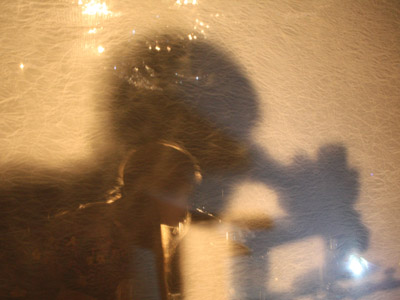Back in the days of Andy Warhol, art had its "Factory." Now, it has a lab.

Right now, Exit Art, a Manhattan art gallery, is exhibiting a number of science-inspired works in an exhibit called "Corpus Extremus (LIFE+)". As this New York Times review points out, many of the works are totally off-the-wall, from a movie projected onto living cells and viewed through a microscope to a performance artist who had a prosthetic ear outfitted with a microphone surgically attached to his forearm.
Despite the weirdness of some of its content, what makes this show most interesting to me is the hands-on experience some of these artists have gained in labs. The artistic interest in science isn't new, but the approach is unique. They aren't just reading the work of scientists and reinterpreting it artistically; they're making an effort to get inside the process of science, to explore its tools and methods, and to understand it not as outsiders but as truly involved parties. They're able to do this, in part, because scientists and formal science departments are getting on board with this new brand of science-influenced art. The collaboration is pretty cool to see.
One of the organizations supporting the exhibit, and to which many of the artists involved have some connection, is SymbioticA, which describes itself as a "centre of excellence in biological arts." Founded in 2000 by a cell biologist, a neuroscientist, and an artist as a division of the School of Anatomy and Human Biology at the University of Western Australia, it holds academic courses, hosts resident artists, puts on workshops, and supports various projects, all devoted to "exploring the possibilities" of the world in which scientists work. The artists there aren't doing scientific research, but they are getting a taste of what scientists actually do, by studying under scientists and working in a "wet biology," or experimental, environment.
If you're interested in investigating the connections between art and science further, check out one of my favorite science blogs at bioephemera and, of course, all our Science Chicago programs on the topic, including Ars Scientia at the Chicago Cultural Center, the Buckminster Fuller exhibit at the MCA, and much more.
-Tim
Author's Note: This was submitted to the blog by Tim, one of our corespondents.
Sources:
http://www.exitart.org/site/pub/exhibition_programs/corpus_extremus/index.html#about/
http://www.nytimes.com/2009/04/14/science/14corp.html?_r=1&ref=science
http://www.symbiotica.uwa.edu.au/welcome/about_us
http://scienceblogs.com/bioephemera/
http://ars-scientia.org/home.html
http://www.mcachicago.org/buckminster/
Editor's Note: For more blogs from Dr. Rabiah, visit Science Chicago's website at: http://www.sciencechicagoblog.com